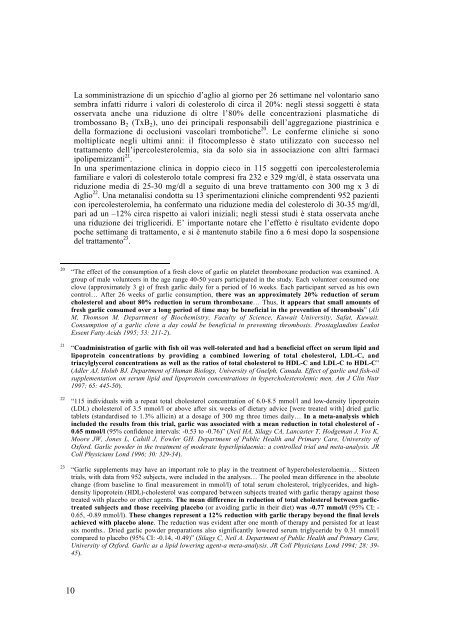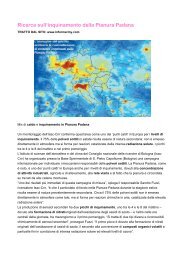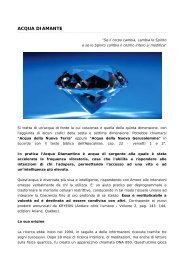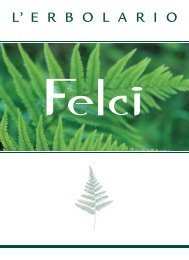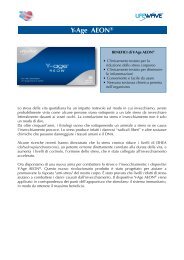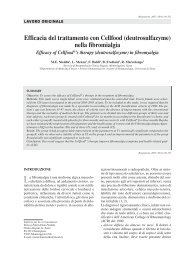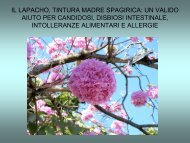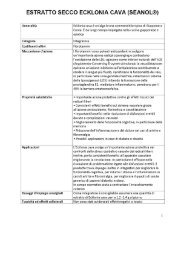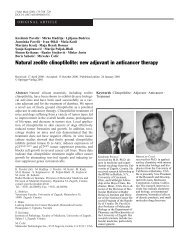guida bibliografica ai piu' noti fitoterapici - Erboristeria.org.uk
guida bibliografica ai piu' noti fitoterapici - Erboristeria.org.uk
guida bibliografica ai piu' noti fitoterapici - Erboristeria.org.uk
You also want an ePaper? Increase the reach of your titles
YUMPU automatically turns print PDFs into web optimized ePapers that Google loves.
La somministrazione di un spicchio d’aglio al giorno per 26 settimane nel volontario sanosembra infatti ridurre i valori di colesterolo di circa il 20%: negli stessi soggetti è stataosservata anche una riduzione di oltre l’80% delle concentrazioni plasmatiche ditrombossano B 2 (TxB 2 ), uno dei principali responsabili dell’aggregazione piastrinica edella formazione di occlusioni vascolari trombotiche 20 . Le conferme cliniche si sonomoltiplicate negli ultimi anni: il fitocomplesso è stato utilizzato con successo neltrattamento dell’ipercolesterolemia, sia da solo sia in associazione con altri farmaciipolipemizzanti 21 .In una sperimentazione clinica in doppio cieco in 115 soggetti con ipercolesterolemiafamiliare e valori di colesterolo totale compresi fra 232 e 329 mg/dl, è stata osservata unariduzione media di 25-30 mg/dl a seguito di una breve trattamento con 300 mg x 3 diAglio 22 . Una metanalisi condotta su 13 sperimentazioni cliniche comprendenti 952 pazienticon ipercolesterolemia, ha confermato una riduzione media del colesterolo di 30-35 mg/dl,pari ad un –12% circa rispetto <strong>ai</strong> valori iniziali; negli stessi studi è stata osservata ancheuna riduzione dei trigliceridi. E’ importante notare che l’effetto è risultato evidente dopopoche settimane di trattamento, e si è mantenuto stabile fino a 6 mesi dopo la sospensionedel trattamento 23 .20212223“The effect of the consumption of a fresh clove of garlic on platelet thromboxane production was examined. Agroup of male volunteers in the age range 40-50 years participated in the study. Each volunteer consumed oneclove (approximately 3 g) of fresh garlic d<strong>ai</strong>ly for a period of 16 weeks. Each participant served as his owncontrol… After 26 weeks of garlic consumption, there was an approximately 20% reduction of serumcholesterol and about 80% reduction in serum thromboxane… Thus, it appears that small amounts offresh garlic consumed over a long period of time may be beneficial in the prevention of thrombosis” (AliM, Thomson M. Department of Biochemistry, Faculty of Science, Kuw<strong>ai</strong>t University, Safat, Kuw<strong>ai</strong>t.Consumption of a garlic clove a day could be beneficial in preventing thrombosis. Prostaglandins Le<strong>uk</strong>otEssent Fatty Acids 1995; 53: 211-2).“Coadministration of garlic with fish oil was well-tolerated and had a beneficial effect on serum lipid andlipoprotein concentrations by providing a combined lowering of total cholesterol, LDL-C, andtriacylglycerol concentrations as well as the ratios of total cholesterol to HDL-C and LDL-C to HDL-C”(Adler AJ, Holub BJ. Department of Human Biology, University of Guelph, Canada. Effect of garlic and fish-oilsupplementation on serum lipid and lipoprotein concentrations in hypercholesterolemic men. Am J Clin Nutr1997; 65: 445-50).“115 individuals with a repeat total cholesterol concentration of 6.0-8.5 mmol/l and low-density lipoprotein(LDL) cholesterol of 3.5 mmol/l or above after six weeks of dietary advice [were treated with] dried garlictablets (standardised to 1.3% allicin) at a dosage of 300 mg three times d<strong>ai</strong>ly… In a meta-analysis whichincluded the results from this trial, garlic was associated with a mean reduction in total cholesterol of -0.65 mmol/l (95% confidence intervals: -0.53 to -0.76)” (Neil HA, Silagy CA, Lancaster T, Hodgeman J, Vos K,Moore JW, Jones L, Cahill J, Fowler GH. Department of Public Health and Primary Care, University ofOxford. Garlic powder in the treatment of moderate hyperlipidaemia: a controlled trial and meta-analysis. JRColl Physicians Lond 1996; 30: 329-34).“Garlic supplements may have an important role to play in the treatment of hypercholesterolaemia… Sixteentrials, with data from 952 subjects, were included in the analyses… The pooled mean difference in the absolutechange (from baseline to final measurement in mmol/l) of total serum cholesterol, triglycerides, and highdensitylipoprotein (HDL)-cholesterol was compared between subjects treated with garlic therapy ag<strong>ai</strong>nst thosetreated with placebo or other agents. The mean difference in reduction of total cholesterol between garlictreatedsubjects and those receiving placebo (or avoiding garlic in their diet) was -0.77 mmol/l (95% CI: -0.65, -0.89 mmol/l). These changes represent a 12% reduction with garlic therapy beyond the final levelsachieved with placebo alone. The reduction was evident after one month of therapy and persisted for at leastsix months.. Dried garlic powder preparations also significantly lowered serum triglyceride by 0.31 mmol/lcompared to placebo (95% CI: -0.14, -0.49)” (Silagy C, Neil A. Department of Public Health and Primary Care,University of Oxford. Garlic as a lipid lowering agent-a meta-analysis. JR Coll Physicians Lond 1994; 28: 39-45).10


